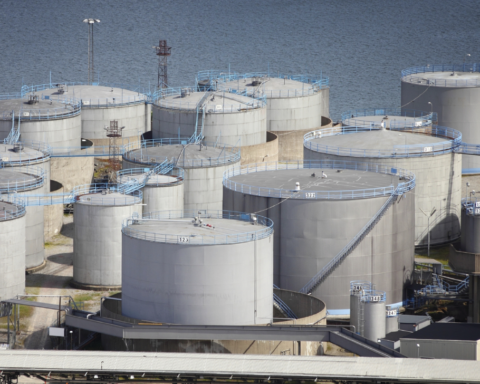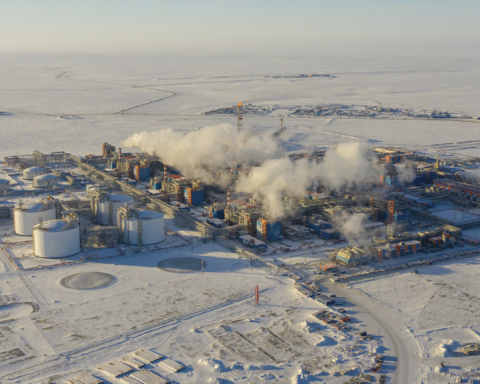Sergey KUDRYASHOV
General Director of JSC Zarubezhneft
e-mail: pr@nestro.ru
Oleg AKIMOV
Deputy General Director for Production of JSC Zarubezhneft
e-mail: pr@nestro.ru
Alexander MIKHAILOV
Head of Department for Russian-Vietnamese Projects
of JSC Zarubezhneft
e-mail: pr@nestro.ru
Alexander BOLDYREV
Head of the Corporate Communications Department of JSC Zarubezhneft
e-mail: pr@nestro.ru
At the origins of the agreement
It is believed that everything began with the visit of Ho Chi Minh in Baku in July 1959. After visiting the “Oil Rocks” deposit, the first offshore oil production complex in the USSR, Ho Chi Minh, in his address to the leaders of the AzSSR, drew analogies with Vietnam and expressed his hope for finding oil deposits in his country. But in those days, it was impossible to start searching – there was a fierce war between the North and the South.
Before World War II, the territory of Vietnam was part of the French colonial empire.
The First Indochina War against the colonialists, which began in 1946, ended in 1954 with the division of Vietnam into two parts: in the north, the Democratic Republic of Vietnam, gravitating towards Moscow, was created, and in the south, the west-oriented state of Vietnam.
It was assumed that in 1956 both parts of Vietnam would have elections held to determine the future political regime and the reunification of the country, but the South ignored this action and announced the creation of an anti-communist state. As a result, already in the late 1950s, a partisan movement began, which by December 1960 united into the National Liberation Front of South Vietnam, known in the west as the Viet Cong (translation of the “Vietnamese communist”).
A year later, the USA intervened in the conflict, supporting the South with the implementation of regular units of its armed forces. But the partisan detachments of the North continue to expand their controlled territories, and already in August 1964, the Americans entered a large-scale war in Southeast Asia.
One of the most brutal and dangerous wars in the second half of the 20th century lasted for over 10 years. With the active support of the USSR, the North Vietnamese troops waged a fierce struggle with the enemy, but the forces were incommensurable. The country lay in ruins, millions of casualties, thousands of kilometres of scorched forests and chemical-poisoned lands.
It seemed that there was nothing left. The national liberation struggle of Vietnam received public support – everyone asked to stop this madness, and after the signing of the Paris Peace Agreement in January 1973, American troops finally left Vietnam.

Source: Zarubezhneft
In the spring of 1975, North Vietnamese troops launched a large-scale offensive into the remaining territories of South Vietnam and captured Saigon. The end of the war. The long-awaited reunification of the people, North and South. Now the new country, the Socialist Republic of Vietnam (SRV), was faced with the main task – to restore the economy.
Why did the Americans need Vietnam so much? Why did they make such sacrifices and were ready to wipe out almost all the people of the country from the land? There are many political and economic prerequisites, and one of them is oil.
By that time, the oil era had come around the world, the whole life of society began to revolve around internal combustion engines and, accordingly, fuel for it. Oil prices rose steadily, there was an active development of new territories and the search for new deposits. Already in 1966, American companies began the first prospecting and exploration work in the territories of South Vietnam. They explored everything – both land areas and the adjacent shelf.
In 1974-1975 Mobil even started deep drilling to test two Miocene formations 115 km offshore and saw the first oil flows as a result. But exactly at that moment the Saigon regime finally fell, and the American oilmen hastily left the country.
This discovery was a joyous event in the history of the new country, because Vietnam did not belong to the number of oil-producing countries and was forced to import fuel and lubricants from the USSR, Iraq, Libya, Kuwait, etc.
For a long time, all attention was paid only to the north of the country – it was believed that the Hanoi trough had favourable conditions for the formation of oil and gas deposits. But experts from the USSR, after two years of searching, ascertained the absence of any significant deposits of oil and gas.
In late 1975, the Vietnamese found the South Vietnamese Oil Company. The country destroyed by the war did not have its own resources to continue the development of the shelf. Since the Soviet Union for a long time refused to help, companies from Canada, Germany and Italy were invited, which, since 1979, have drilled 12 wells that showed signs of oil-bearing capacity, but nothing more.
A new round of political complications and imposed international sanctions forced Western companies to leave Vietnam, but by that time the situation in the USSR had also changed – in the late 1970s, the sea development direction began to develop actively. Therefore, when Vietnam once again asked for help in developing its oil deposits, the Soviet Union met halfway.
On July 3, 1980, an agreement was signed between the governments of the SRV and the USSR on cooperation in the field of geological exploration and oil and gas production on the continental shelf of southern Vietnam, and almost a year later, on June 19, 1981, an intergovernmental agreement was adopted on the establishment on a parity basis of a joint Soviet -Vietnamese enterprise. It was a non-standard solution for both states, but the scale of the project required responsible interaction between the two parties on equal terms. This was the beginning of a large Soviet-Vietnamese project, already 40 years long.
Discovery of the White Tiger
Now it is difficult to imagine, but the fate of the entire project could not only have turned out differently, but also ended before it began. The fact is that, pursuant to the results of the expeditions of Soviet specialists to Vietnam in 1979, the assessment of the prospects for the oil and gas potential of the shelf was rather negative and the expediency of the USSR’s participation was a big question.
Ostap Sheremet, in those years the chief geologist and deputy head of Glavmorneftegaz, intervened in the matter. He was an experienced oilman who worked for many years in Sakhalin and the Komi Republic, and with the support of experts I. P. Zhabrev and V.P. Tolmachev ensured that the calculations were rechecked with the participation of experienced specialists from Sakhalin, Baku and Vietnam. As a result of the new examination, a completely different conclusion was issued, which marked the beginning of work on the Soviet-Vietnamese oil project.
Initially, Vietsovpetro planned to start drilling already in 1983, but lengthy approvals and a plan to supply a self-submersible drilling rig were thwarted. As a result, the “Mikhail Mirchink” drilling vessel was sent to Vietnam on an emergency basis, which started drilling an exploration well only on December 31, 1984. For obvious reasons, they began to look for oil where it was once found for the first time – at the Bach Ho deposit, which is translated from Vietnamese as “White Tiger”.
When the first well test was performed in May 1984, only one of the objects in the interval of 2782-2826 m was productive, confirming the presence of oil and water with a flow rate of 26.2 m3/day at 7.9-mm choke and 5 m3/day of water.

Source: Zarubezhneft
The specialists were at a loss, since the numbers did not meet the plans for the technical and economic efficiency of the project, but for Vietnam it was a huge event – all over the country people passed on to each other: “Vietnam has oil!”
Discussions began within the project group, many expressed skepticism about the deposit, and then it was decided to go north and drill a new well 4-BT to the design depth of 3501 m. Everyone waited with bated breath for the test results. Intuition did come through.
It turned out that not only Miocene, but also deeper Oligocene sediments are productive at the deposit – an oil flow of 200 tons per
day was obtained, and the total flow rate from nine layers of Oligocene sediments was 1300 t per day.
Based on the data obtained, the geologists recalculated the reserves of the White Tiger deposit, which already allowed to speak of industrial oil production. New prospects have opened up for Vietsovpetro. What was on the verge of collapse began to develop at an accelerated pace – the landscape of the shelf was changing in sight, here and there stationary offshore platforms (SOP) grew up.
In 1984-1986 drilling operations at JV Vietsovpetro were led by one of the main characters in the history of the White Tiger, Vladimir Stepanovich Vovk. According to him, after the completion of the construction of SOP-1, when they started drilling the first production well, they reached the foundation and began to absorb the drilling fluid. To prevent it, they began to use improvised means – they turned out to be rice husks.
When the situation returned to normal, everyone present began to analyse what had happened and concluded that there are cracks that could potentially contain oil.
The drillers were already going to take a risk and drill another 20 m to test the well, but at that moment the management intervened, forbidding any experiments, based on the opinion that there could be no oil in the granite formations. The result – about 86 cub.m of oil per day, suited everyone. For 1986, this was enough to order the start of commercial oil production at the White Tiger.
However, very soon the productivity of the first well gradually began to decline, and by the end of 1986, the production rate was only 17 tons. Reservoir pressure was decreasing and it was necessary to switch to artificial lift, and this required time and new costs, and against the background of not the best indicators for mining. The situation worsened, JV Vietsovpetro began to face great difficulties.

Source: Zarubezhneft
And now, by coincidence, Vladimir Vovk, who left Vietnam in 1986, accepting an invitation to head Chernomorneftegaz, two years later returns to the shelf to rectify the situation at the White Tiger. He immediately gets down to the idea of testing the foundation, especially since now he was supported by geologists.
Drilling to the foundation turned out to be not easy: we carefully and consistently moved on and on, until the bell rang on September 6, 1988 in the middle of the night – the well started working, the pressure was about 120 atm. When the well was put into operation, within an hour the production rate was 1200 tons of the purest oil. There was a lot of oil on the White Tiger, but where no one expected to find it – in granites!
White Tiger is a unique offshore deposit. According to drilling data, the height of the massive reservoir here was more than 1.5 km, and the reserves were estimated at more than 500 mln t of crude oil and tens of billions of cubic meters of associated gas.
Moreover, the oil produced was of high quality: it was light and sulfur-free.
Since the discovery of oil deposits in granites, production has grown rapidly: by 1990, JV Vietsovpetro showed an almost 10-fold increase. New stationary platforms were erected, and the enhanced ones – up to 22 wells. The company was entering a new era – the 1990s will become the true heyday of Vietsovpetro.

Source: Zarubezhneft
New chapter
JV Vietsovpetro was created as a joint venture between the two states, therefore, when by the end of the 1980s the Soviet Union was on the verge of disintegration and collapse of the system, this began to affect the financing of the Vietnamese project. Already in July 1988, negotiations began between representatives of the governments of the USSR and Vietnam on the need to amend the agreement of June 19, 1981 – an urgent need to adjust to meet the new economic realities.
Long negotiations finally led to the conclusion of a new Intergovernmental Agreement on the continuation of cooperation in the field of geological exploration and oil and gas production on the continental shelf of the south of SRV within the framework of the Vietsovpetro joint venture, which, from January 1, 1991, was supposed to operate on the principles of cost accounting, self-financing and self-sufficiency.
The joint venture was empowered to conclude contracts for the supply of equipment, materials and services necessary for production and economic activities.
Moreover, the areas of activity of both parties were divided, the rent for the use of land, water and sea spaces, the amount of taxes, distribution of profits and the statutory fund were determined. The agreement was extended by 9 years.
What was once created as an act of support by the Soviet Union for a friendly state has taken on a new form of work in accordance with world economic standards. Thanks to the discovery of massive oil deposits at the White Tiger, Vietnam’s economy began to gain momentum in the 1990s. Active production, development of the deposit infrastructure and further development of new offshore deposits have turned the world view of Vietnam upside down. Foreign companies began to invest in the Socialist Republic of Vietnam. Even the Americans could not resist – in 1994, the USA lifted the embargo against SRV, and in 1995 established diplomatic relations with Hanoi. New oil and gas deposits began to appear on the shelf map, but none of them managed to repeat the success of the White Tiger.
In the early 2000s, JV Vietsovpetro produced about 80% of all oil in Vietnam.

Source: Zarubezhneft
Many new industries throughout the country began to develop at the expense of the resources and scientific base of the White Tiger: electricity, information technology, mechanical engineering, assembly and assembly work, construction and repair of drilling platforms, communications and communications, banking, shipping and the petrochemical industry. In 1995, the construction was completed and the first offshore gas pipeline was put into operation, which supplied associated gas to the Phu My nitrogen fertilizer plant.
The development of the White Tiger and other deposits on the shelf in the south of Vietnam has become a source of significant revenues in the country’s budget. For the period from 1991 to 2010, the total revenue of JV Vietsovpetro amounted to 50 bln USD, in 1999 the oil production of the joint venture exceeded 12 mln t. In the same years, Vietnam demonstrated one of the highest rates of development: GDP grew by 8.5% per year.
Development vector
In the early 2000s, when Vladimir Putin came to power in Russia, the country’s oil and gas sector was on the rise and cooperation with Vietnam was recognized as one of the key sectors of the economy. JV Vietsovpetro again acquired the status of a conductor of friendly relations between the two states, which helped develop the Russian-Vietnamese oil project.
In 2003, the production of JV Vietsovpetro reached a historical maximum of 13.5 mln t, after which a natural decline began. Three years later, oil production decreased by 27% and amounted to 9.8 mln t, and three years later – production dropped to 6.5 mln t. This caused concern in the Vietnamese government, and it was necessary to urgently look for new solutions.
Few people expected new discoveries from the White Tiger, it seemed that the entire base had been exhausted, but due to the development of science and the developed new approaches to working with terrigenous deposits, it became possible to breathe new life into the old deposit. Active exploration and development of new blocks of the deposit allows new discoveries to be made almost every year.
It seemed that only recently a big event was the development and commissioning of wellhead platform No. 20 in the South-Western part of Block 09-1 (2019), as a new one arrived – two oil and gas deposits were discovered on Block 09-2/09: Kinh Ngu Trang and Kinh Ngu Trang Nam, with commercial reserves of 28.3 mln t of oil and 10.2 bln m3 of gas.
On January 25, 2019, the long-awaited commissioning of the new Beluga deposit took place: the initial production rate of three wells amounted to more than 10 thousand barrels per day, which is more than the planned one by more than 25%.
Today JV Vietsovpetro is a powerful industrial and technological complex for oil production in the Asia-Pacific region (APR), which bears a key status in the multifaceted and mutually beneficial economic relations between the two countries.







